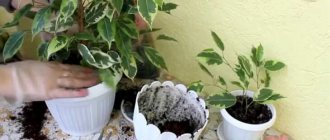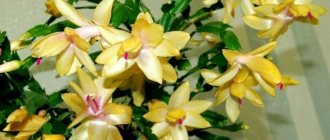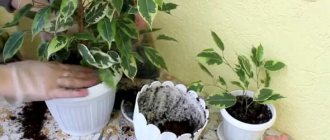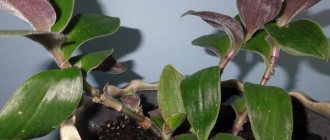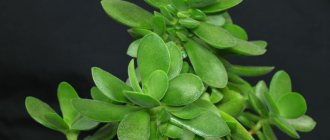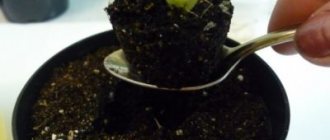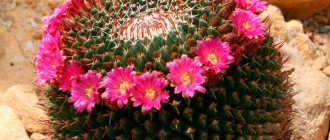Sooner or later, everyone who grows Schlumbergera at home has a desire to propagate this beautiful plant. The most common method of propagation of the Decembrist is vegetative, by cuttings. This method is popular due to its simplicity and high rooting rate.
A cutting is a part of a plant that is used for vegetative propagation. After planting in the substrate, the cutting will develop roots and buds and grow into a new plant. Cuttings for all varieties of Decembrist occur the same way.
When is the best time to take cuttings?
By propagating Schlumbergera using cuttings, you can get a new flower while maintaining all the specific characteristics of the mother plant.
During flowering, the Decembrist should not be disturbed or taken for propagation material. The most suitable time for cuttings is the beginning of spring , when the flowering period of the zygocactus ends and the growing season begins.
If it was not possible to separate the cutting in the spring, it can be taken in the summer, when the bush is forming.
Peculiarities of Decembrist leaf propagation
First of all, you need to decide on the breeding time. The most favorable time is considered to be the beginning of April and the end of May, when the plant has already bloomed and is in the resting phase. However, experts say that you can propagate a flower from a leaf at any time of the year, and it will grow the same way. Be sure to ensure that this happens after flowering, so that the transplant does not in any way affect the condition of the adult Decembrist.
Leaf propagation
After this, you need to pay attention to the choice of the cutting itself. An ideal cutting should be without any damage, not wilted and should consist of at least 3 parts. For such purposes, a shoot already with roots is chosen. In order to get a larger plant in the future, you need to take several cuttings. Also, experienced flower growers recommend selecting children in places where they grow abundantly, since even more shoots will appear in their place.
Advice!
It is best to choose babies at the base of the stem of the mother flower, as this will cause the least harm.
After the cutting is separated, it is necessary to sprinkle the tearing area on the mother plant with charcoal in order to prevent the entry of microorganisms.
How to determine that a shoot is ripe?
Choosing a shoot suitable for cuttings is not difficult. It is necessary to carefully examine the Schlumbergera and find long, weakly branched or not branched stems at all. In this case, it is possible to pinch the stem of the zygocactus so that it begins to branch, and to separate the cutting for propagation.
You should choose strong and healthy shoots, with good turgor, without scratches, cracks and other mechanical damage to the leaf plates. It is desirable that they have aerial roots.
Shoots suitable for propagation must have at least 2, and preferably 3, segments. In some cases, it is possible to root even one leaf, but with a less predictable result. It also makes no sense to take shoots with 5 or more segments - long cuttings are inconvenient to work with.
Reference! In order to get a lush bush, several cuttings should be taken at once.
Description
Decembrist belongs to a large family of forest cacti. In its natural environment, this epiphyte can be found in the tropical rainforests of South America, where it grows on the branches and roots of trees. Zygocactus was brought to European countries at the beginning of the 19th century, and it instantly won the love of flower growers, thanks to its unpretentious character and high decorativeness.
Zygocactus Schlumbergera is an evergreen shrub reaching 30–50 cm in height. It has a voluminous crown consisting of hanging stems. The shoots are formed from segments resembling dense leaves.
The culture blooms in winter, which is why it got its name. Cactus buds form at the tops of the stems. Peduncles are tubular, multi-tiered, with long stamens. The petals are colored in red, white, yellow, purple and pink.
Thanks to the work of breeders, many varieties of flowers have been obtained. The following varieties are especially popular:
- Decembrist Rousselian. The variety is characterized by rapid growth. Its shoots reach up to 80 cm in height. The leaves are flat, grooved at the edges, and dark green in color. The petals of large peduncles are slightly pointed at the tips.
- Gertner's Decembrist. A large shrub covered with dense, fleshy leaves. The bell-shaped peduncles are painted in rich bright orange colors.
- Decembrist Bookley. The plant reaches up to half a meter in height. The buds are large, multi-tiered, up to 8 cm long. The variety is distinguished by long flowering, which begins in November and ends in March.
If you create comfortable conditions, then any of these varieties of zygocactus will become a decoration of the collection. This is confirmed by the following photo of the Decembrist flower.
What soil is suitable for planting?
The soil for planting cuttings should be light and loose. You can purchase ready-made soil intended for cacti or universal peat-based soil at a flower shop. also prepare the soil mixture yourself . To do this you need to mix in equal proportions:
- leaf soil;
- turf land;
- peat;
- river sand.
To improve its structure, add perlite and crushed sphagnum moss to the resulting soil mixture.
The main requirement for the soil is that its acidity should not exceed pH 5.0-6.5.
Which container is best to choose for rooting?
Zygocactus has a small and weak root system, especially if we are talking about a very young plant. In addition, after thorough rooting of the cuttings, they need to be transplanted into soil with a more nutritious composition, so rooting does not require a large container . You can use plastic cups or small flowerpots with a volume of approximately 150-200 ml.
There must be drainage holes at the bottom of the container used, and immediately before planting the cuttings, it is necessary to pour a drainage layer into it at least 1/3 of the height, which can be expanded clay, perlite, vermiculite, broken brick or small pebbles.
Short description
Decembrist is original and unusual, differs from all cacti in the absence of spines, loves water and does not receive much sun. It blooms in winter, when most decorative flowers are dormant.
This plant has many names, the most famous are Varvarina spit, zygocactus, epiphyllum, crayfish neck and Rozhdestvennik.
- There is another name - Schlumbergera. This is a botanical name that is shared by three species of cactus: Schlumbergera gärtnera, Schlumbergera truncata and Schlumbergera boucleia. Its origin is simple to explain - given in honor of the breeder Frederick Schlumberger, a breeder from France. But we call this decorative flower quite rarely.
- The homeland of the plant is considered to be the humid forests of South America, in particular Brazil. In nature, reproduction occurs by spreading away from the center of the bush.
- The plant belongs to the genus of South American epiphytic cacti that live on trees, or rather, their branches. They were brought to our region back in 1816 by collector Allan Cunningham and, over time, became real pets of many flower growers.
- We are accustomed to calling this tropical plant the Decembrist, because its peak flowering occurs on December 17, and during the New Year holidays the Christmas tree pleases us with lush flowers.
- The branches of the plant are presented in the form of flattened, articulated shoots (segments), which become woody as they grow.
- Flowers appear on the shoots, arranged in tiers. The color palette can be very diverse: soft lilac, lavender, pink, cream, red, coral, light orange. The most famous and recognizable is considered to be a gentle crimson color.
- The root system is rather poorly developed. If the conditions are not entirely suitable for the flower, it may quickly die. But, despite this, the search roots tend to quickly recover and develop a normal, full-fledged root system.
- Today, breeders are developing more and more new varieties and hybrids that can bloom not just once a year, but as many as 3 times, and their colors are more varied.
Step-by-step instructions on how to root Schlumbergera
To separate the selected cutting, you need to pinch it with your fingers and, turning clockwise, carefully unscrew it from the mother plant, holding the branch with your other hand.
Under no circumstances should you use scissors, a scalpel, a knife or any other sharp objects, otherwise the planting material may be damaged.
The separated cutting must be dried for 48 hours by placing it on a napkin and putting it in a dark place, after which a thin film will appear on the detached area.
For rooting there are 2 equal options: in soil and in water.
In water
It is necessary to place the cutting in water at room temperature so that it covers 1 of its segments. If the water level drops, it should be added. It is important to monitor the condition of the water: if it becomes cloudy, it must be replaced immediately and the cuttings must be washed to avoid the possibility of rotting.
The roots appear after 7-14 days ; you can speed up this process by adding a few “Kornevin” to the water.
When the roots reach a length of more than 2 cm, the cuttings need to be transplanted into the ground.
Important! The water used must stand for at least 24 hours so that chlorine and its derivatives are removed from it, otherwise the young zygocactus may die.
In the ground
You need to thoroughly wash and disinfect the container for planting the cuttings, add a drainage layer and prepared soil to the bottom. Next, you should water the soil and vertically deepen the cutting into it by about 5 mm.
If a large pot is chosen as a container for planting, 2-4 cuttings should be planted in it, if a plastic cup - 1.
It will take about a month for the zygocactus to take root in the soil . To speed up the growth of roots, “Kornevin” is used - you should dip a cut of the shoot into it before planting.
How to propagate Decembrist at home with seeds
This method of propagating zygocactus is not very popular. Many gardeners do not even know that Schlumberger can be grown in this way.
Seed selection
Christmas cactus seeds can be purchased either ready-made in specialized stores or kiosks, or you can get them yourself. From a technical point of view, this process is not difficult, but it will require more effort and time from you. To create a new hybrid, you need to artificially pollinate two plants. Namely, transfer the pollen of one cactus to the stigma of another flower. This can be done with a brush.
Important! Plants taking part in pollination should not be related. Pollination is best done on the second or third day of flowering.
Practice shows that zygocactus pollen retains its properties for several weeks. Therefore, if the flowering periods do not coincide, this is not a problem. It is necessary to collect pollen from a flowering plant and store it in paper until the second cactus blooms.
In a couple of days, the unpollinated flowers will wither, and ovaries will appear in the pollinated buds. The Schlumberger berry grows to its final size within thirty days, and the period of final ripening ranges from six to eight months. During this period, the berry becomes soft, and many small seeds (up to 50 pieces) ripen inside it. In appearance, the Christmas tree seed resembles a poppy seed. Peeled and dried seeds retain the ability to reproduce for three or even four years.
Know! When crossing zygocactus, the dominant colors are orange and red. That is, if you want to get a specimen with yellow or white flowers, then their “parents” must certainly have light colors.
Preparing seeds for sowing
Before planting, Christmas cactus seeds must be soaked briefly or thoroughly washed in a solution of manganese or peroxide (three percent).
The most effective seeds for growth are those obtained a year ago. They should be stored in a linen bag, observing the temperature regime (room temperature) and air humidity (40-50%). Before planting, the seeds must be warmed up for two days, ensuring a temperature of forty to sixty degrees Celsius. To increase the likelihood of germination, you can soak the seeds in a one percent solution of sodium humate.
When and how to sow seeds
It is recommended to sow zygocactus seeds in the spring. Sowing must be done directly on the soil surface. There is no need to sprinkle soil, just lightly press the seeds to the surface. The first shoots can be expected within three weeks.
Soil and containers for sowing
For sowing, it is necessary to use universal soil mixed with sand. Sowing can also be done in clean sand. Seeds can be sown either in open ground or to create a greenhouse effect using glass or cellophane. A prerequisite is to ensure daily ventilation.
Before sowing, it is advisable to treat the dishes with alcohol and rinse the sand. It is necessary to provide the soil with good moisture. The soil should be well loosened, and the room temperature should be at least twenty degrees Celsius.
Seedling care
The container with seeds should be well lit. If there is not enough sunlight, you need to place the seedlings under a lamp. It is very important to provide the “kids” with regular and even hydration. You should not water the seedlings; it is better to use a sprayer.
Schlumberger seedlings are not whimsical. They are resistant to rotting and can withstand drying out quite well. When the roots have appeared, the seeds are transplanted into the substrate.
Know! Bowls with the remainder of ungerminated seeds should continue to be moistened regularly, since the rest of the seedlings will certainly germinate, even after a long period.
Seedling care
For the first year and a half, the “babies” can be kept in a common container, then they must be seated in separate containers. Two months after germination, fertilizers can be applied to young plants. During the first year, growth is very slow. The first flowering should be expected no earlier than a year and a half later. The typical form of an adult flower is acquired after approximately four years.
Picking and transplanting
Picking can be done one and a half months after germination. During this period, a second leaf, the so-called “segment,” should appear. If available, you can dig up the roots and plant the seedlings in separate small containers. Basic picking rules:
- To separate the seedling from the soil, it is necessary to make a careful dig. It is better to get the “baby” with your hands or tweezers with rubber tips.
- Before the picking procedure, it is necessary to thoroughly moisten the soil and make small holes in it. The seedling is transferred to a new place directly with a lump of soil.
- The seedlings remain in the same conditions as before in terms of temperature and light.
- To ensure the necessary moisture, the soil is periodically sprayed.
- You can remove seedlings from heating a couple of weeks after picking.
Important! In the first year of life, picking should be done once a quarter, and the next year - every four months.
Difficulties and problems of cuttings
When taking cuttings you may encounter some problems:
- the leaf segments turn red - this is probably due to direct sunlight on the young plant;
- the cuttings wither - this occurs due to violation of the rules for caring for the plant (watering and spraying with cold water, excess fertilizing) or the development of a fungal infection;
- the cutting is rotting - most likely the problem is an excessive amount of moisture; it is necessary to remove the cutting from the soil, remove the damaged parts, dry it for 48 hours and plant it in new soil, reducing watering.
Caring for a young plant
- To maintain a stable microclimate and a high level of humidity after planting the cuttings in the soil, you need to create a greenhouse effect by covering the cuttings with a jar or bag.
- The cuttings must be placed under diffused lighting at a temperature of about +15-20 degrees. The greenhouse needs to be ventilated daily for 30-40 minutes to remove any condensation that appears.
- The soil should not be watered abundantly; it should be moderately moist; watering can only be done after the top layer of soil has completely dried, otherwise the cuttings will rot. It is better to replace watering by spraying with warm, soft water.
Attention! Until the zygocactus is completely rooted, containers with cuttings cannot be moved.
- When new segments appear on the shoots, they need to be transplanted into a flowerpot made of a small plastic glass. Replanting should be done using the transshipment method, leaving an earthen lump around the weak roots.
Decembrist has a shallow root system that does not require deep planting, so the flowerpot should be low and wide, always with drainage holes .
If the rooting of the zygocactus took place in a flowerpot, the flower should not be disturbed for several months, until the roots appear in the drainage holes, speaking of filling the soil.
After transplantation, Schlumbergera needs to be placed in the shade for 10-14 days so that the flower recovers from stress. During the adaptation period, watering should be replaced by spraying. After this, it is advisable to place the rooted cuttings in partial shade on a balcony or veranda. Fertilizers can be applied only after 2-3 months.
Schlumbergera propagation methods, their pros and cons
Cuttings
Propagation by cuttings or leaves is the easiest and most common way to propagate this flower at home. Immediately after flowering, in February - March, pruning is required to form new branches and thicken the bush itself. Trimmed tops – segments – are an excellent “material” for cuttings.
Important: You can root cuttings in spring or autumn - the best period for germination and rooting.
This method gives almost 100% results, and every lover of exotic flowers can do it.
When rooting shoots in a glass of water, do not overexpose the cuttings. It may rot. As soon as new shoots appear, the cuttings must be planted in a small pot with special soil. It is advisable to use ceramic containers - ceramics prevent roots from becoming waterlogged and normalize heat transfer.
Read about how to plant Decembrist shoots and other methods here.
Seeds
Propagation of Christmas tree by seeds at home is almost impossible. Only natural varieties can reproduce under natural conditions using this method. Natural pollination of flowers by insects is required for seed formation. Next, an ovary appears on the pollinated flowers, which gradually becomes denser, lengthens, and the fruit grows to 1.5–2 cm.
The fruits ripen within 3–4 weeks and last a long time. The seeds are orange or pink in color and are found in the pulp of the fruit - berries. Birds peck edible fruits and naturally disperse the seeds.
Grafting
Grafting of Schlumbergera is possible only on standard forms. It is grafted onto cacti - Hylocerius, Selenicerius, etc. This procedure is only available to experienced breeders. This requires special conditions for crossing and maintaining hybrids, knowledge and skill in performing the procedure are required.
